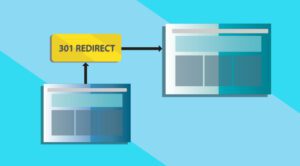
301 redirects: What are they and how do they impact SEO?

Redirects are a way to send both users and search engines to a different URL than the one they originally requested. As you add more pages to your website and certain, older ones become outdated or not needed, redirects can help you signal to search engines how you wish for those digital relics to be treated.
As such, there are a series of redirects that you can turn to – 301 redirects, being one of the most common.
But what exactly is a 301 redirect? And will it impact your website’s technical SEO performance?
Let’s take a look…
What is a 301 redirect?

A 301 redirect is an HTTP status code that indicates the permanent removal of a URL. Say you have a webpage with outdated information and you’ve since produced better, more fitting content elsewhere, you might use a 301 redirect so that anyone trying to visit the old URL is immediately transferred to the new page.
Essentially, think of a 301 redirect as a call-forwarding system. Both the user and search engine are essentially incoming calls trying to access a number you no longer associate with. The redirect you put in place will send them to the correct line (or URL) of where they need to be.
301 redirects vs 302 redirects
Before we go on, it’s worth quickly mentioning a similar type of redirect that you shouldn’t confuse with a 301- the 302 redirect.
As mentioned, a 301 redirect indicates the permanent removal of a URL. Only in this instance should you use it. Should you have a URL that you are removing temporarily, however, then a 302 redirect would be better suited.
- 301 redirect (moved permanently): Use when pages are outdated and not on your agenda to revisit or reuse
- 302 direct (moved temporarily): Use when pages are not yet complete, being updated, or under construction, and you intend to use them once ready
Explore further: Check out our guide for a more comprehensive look at the different types of redirects.
What happens when you use a 301 redirect and how does it impact SEO?

Typically, when you remove content from a URL, any user who then attempts to view that URL will be faced with a 404 error. These are pretty common, and you’ve probably encountered them yourself many, many times.
Now, in this example, when you use a 301 redirect, rather than be stuck at a dead end at a 404 window, the redirect will send the users to your preferred page instead. It is an automated function that ultimately improves the user experience – a consideration that search engines always favour and reward.
The bigger your site gets, the more necessary adopting 301 redirects will be.
It’s only natural – as your business evolves and your content with it, you’ll need to keep your website in check, ensuring that users aren’t landing on parts of the site that no longer adequately serve a purpose.
Using a 301 redirect not only helps users to better navigate your site but has some snazzy SEO benefits too.
Using 301 redirects can affect your website’s SEO performance in 3 key ways…
Preservation of link equity
Link equity (or ‘link juice’ in SEO slang) is a valuable digital commodity. It’s the power that one page passes through to another. When you link from page to page, Google essentially sees this as a nod, a vote of confidence or a referral.
Now, each page has its own link equity that is earned (through any backlinks it’s acquired, amongst other things). When you use a 301 redirect, the new page inherits this equity from the old – it’s passed through. So, you get the added SEO benefit of the new page inheriting the old’s ranking power.
Consideration of user experience and indexing
No one likes a dead end – it’s frustrating, a hassle, and likely to result in people bouncing (unless there’s something on your site that a user is really eager to find, something they can’t easily find elsewhere).
Adopting 301 redirects ensures that no one gets left behind as they navigate your site. It provides a seamless experience for the user, as well as the search bot that periodically crawls and indexes your website.
Consolidation of duplicate content
Duplicate content is a big no-no in SEO. Search engines hate it, penalising content that is a direct copy/paste or even content that serves too similar a function as another page on the website (or the internet as a whole).
When should you use a 301 redirect and what are the best practices?
The times when you should be implementing a 301 redirect are as follows:
- When a page has permanently moved to a new URL
- You’re migrating to a new domain
- Changing URL structure
- Changing site structure
- Redirecting users from a deleted page to a relevant page
Avoid redirect chains
Ah, the dreaded redirect chain. The irrelevant middle ground between the user and their desired destination. In this case, it’s not about the journey, it’s about the destination.
The journey must be short, going from A (oldest) to C (newest) instead of to A (oldest), B (old), and then C (newest). Often, redirect chains are accidental and can slip under the radar. If you don’t resolve them, you risk slowing your page loading time and wasting your crawl budget.
Check if the 301 redirect is necessary
Unnecessary 301 redirects can lead to a build-up of redirects that risks becoming a redirect chain. An SEO audit of your site can reveal where your redirects are and if they’re working properly, and you can determine if any of them are outdated and not required anymore.
Or, you may be using a 301 redirect when you actually need a 302. As mentioned previously, a 302 has different uses but could be better for your site, so it’s worth evaluating your site’s needs.
Redirect to relevant pages
To preserve a positive user experience, you should aim to redirect to relevant pages. It keeps the consistency of your site and prevents a user from being confused.
You also prevent the crawlers from getting confused- an irrelevant page might be detected as a ‘soft’ 404 by the Google search crawlers, so the redirect becomes essentially pointless when not used correctly.
Need a hand? We can redirect your SEO efforts
Using 301 redirects, therefore, is an effective SEO tactic to consolidate duplicate content under a single URL, directing incoming traffic of a similar search intent towards one destination rather than several.
You always need to make sure best practices are implemented, and hopefully, you now understand the redirect’s impact on SEO.
For more on this, get in touch with our team today. We’d be happy to help with your SEO efforts!